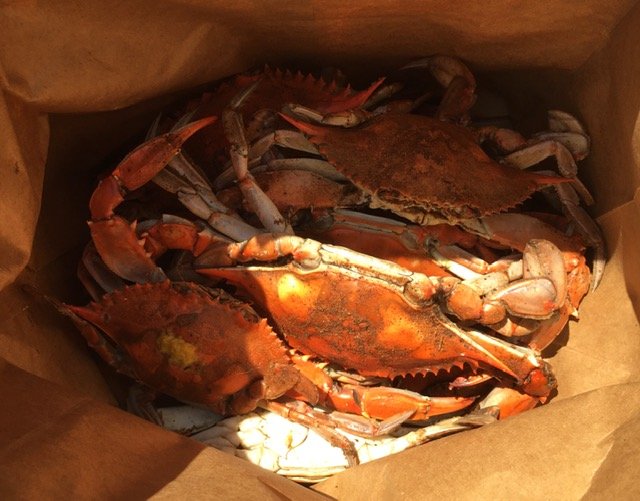Crabby
Family vacations when I was a kid always included a day of crabbing. Dad would put together rigs consisting of a chicken neck weighted down with a spark plug on a string and off we’d trek to an old wooden pier somewhere on the Bay near Rehoboth Beach. We’d squeal, “Got one!” and Dad would come over with his dip net to scoop up the crab nibbling on the neck. He’d measure it to make sure it was large enough to keep and then flip it over to see if it was a male or female. We’d always toss back the females. When our cooler was full, we’d head back to our beach rental to feast on hard shells boiled from their distinctive blue to a brilliant orange gritty with Old Bay seasoning.
When trips to the shore fell out of fashion, the crab feasts continued, only my parents and a group of their friends would save all their aluminum cans all year to turn them in and splurge on a bushel of crabs for Memorial Day.
This year they would have needed 1,200 pounds of aluminum—42,000 cans—to purchase a single bushel of crabs. That’s 7,000 six-packs of beer.
Yeah, I get it, especially as a farmer, that the costs of food production are rapidly rising, much of that attributed to the costs of fuel. But there is another factor at work and that is the availability of the product.
In the 33 years that Blue Crabs in the Chesapeake Bay have been tracked, 2022 has hit record lows. Maryland Department of Natural Resources (DNR) and the Virginia Institute of Marine Science (VIMS), the two agencies tasked with tracking the numbers and managing the fisheries points to a number of factors causing a decline in crab populations—diminished juvenile habitats, warming ocean temperatures, increased pressure from invasive specie predators such as the Blue Catfish, reduced oxygen levels due to nutrient run-off from inland agricultural in the Bay’s watershed.
If you want to help improve the chances of keeping Blue Crabs on your picnic menus you’re going to have to look upstream to your other food choices and how they’re produced. Nutrient run-off is just a more acceptable way of saying farmers are spreading way more manure and chemical fertilizers on their fields that the soil can absorb and therefore it runs off into the local waterways ultimately ending up in the Chesapeake Bay.
It's not only the Chesapeake Bay suffering from nutrient overload. There are over 400 identified hypoxic zones in the world, all caused by nutrient run-off, the largest one being in the Gulf of Mexico caused by excessive nutrients carried from the Midwest by the Mississippi River.
Hypoxic zones occur when algae populations explode due to increased nutrients. The algae die, sink to the bottom, and are decomposed by bacteria—a process that strips dissolved oxygen from the surrounding water. Dense algal blooms also block sunlight, which prevents underwater grasses from growing. Those grasses are the same ones that are critical to Blue Crab populations along with many other species of aquatic life humans enjoy eating along with the rest of the food web.
If you think this isn’t a problem, let me explain something. I, along with most of my fellow farmers at the market are the 1% in agriculture in that we utilize various philosophies and practices of sustainable and regenerative agriculture. One percent…think about that.
I live in a neighborhood county state country that actively promotes the wide-scale destruction of the environment, especially those downstream, the ones consumers don’t necessarily see or smell. By the way, hypoxic zones tend to smell worse than a field slick with liquid manure. At least that crap goes away with the rain which is usually happens right after thousands of gallons get slathered on the ground using monstrous tankers pulled by equally immense tractors. It gets carried by run-off into seasonal streams which feed into local runs dumping out into regional creeks that flow into rivers that the estuaries try to filter before hitting the bays and eventually the oceans.
As consumers have become savvier over the years, I’ve encountered many questions posed by customers as to how their food has been produced. I’ve heard them all and some have led me to alter my own agricultural practices as I’ve become more engaged in the Big Picture.
It’s time eaters learn about no-till farming, riparian buffers, fencing livestock out of waterways, grazing instead of feedlots, wildlife habitats, erosion control, and nutrient management.
If you like your Blue Crabs or any other seafood for that matter, some of the new questions to be asking yourself (and your farmers) when purchasing land-based foods is if it was produced in a manner that promotes the health of our waterways?

